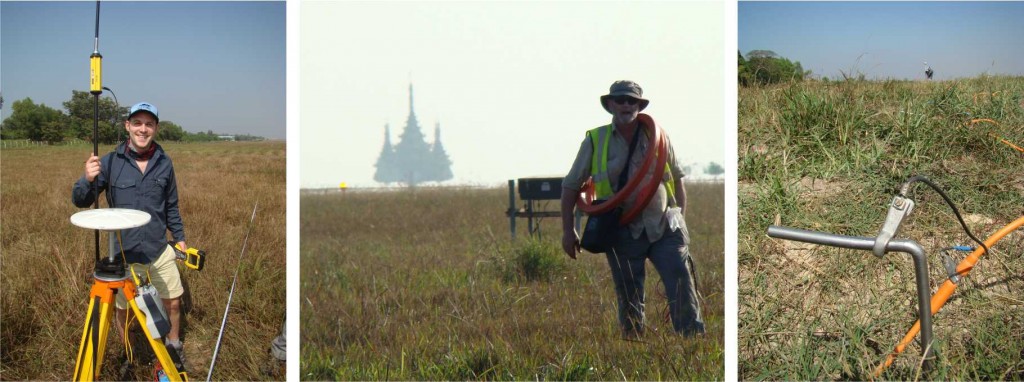Buried beneath the soils of Burma lies a mystery that has been almost 70 years in the making: were a shipment of Spitfire aircraft concealed beneath a British airbase at the end of the Second World War? Dr Adam Booth, a geophysicist at Imperial College London and regular GeoLog contributor, is part of an archaeological team who are trying to unearth the truth in this tale. He’s posting to GeoLog from the field: this Part 3 of the series arrived late due to unreliable internet connection in Burma, but we hope it was worth the wait! Read Adam’s other posts on the Spitfire search here.
13 January 2013
Good afternoon from Yangon! I know it’s been a while, but the geophysics team hit the ground running, surveying almost from day one ahead of this week’s digging. I’m now just grabbing half an hour to begin updating this blog ahead of a reception at the British Ambassador’s residence…! We obviously have made some friends in high places in Myanmar!
Despite a wealth of new geophysical data, acquired by Roger Clark and Andy Merritt of University of Leeds, and myself of Imperial College, I’m afraid I’ll have to leave you with baited breath about whether there are Spitfires buried at Mingaladon! Our business partners are finalising details of our excavation but we’re hoping to break ground very soon. So, I can update you on the geophysical side of the project and how it is to work in Myanmar – but if you’re checking this blog for confirmation of buried Spitfires, you might just have to wait for another few days…!
A typical day of geophysical survey starts around 8am, when we get a taxi from our hotel to Mingaladon Airport, where we are met by our security supervisors and our industry colleagues. The airport is about seven miles away from the hotel, and the journey through Yangon’s chaotic traffic takes around 45 minutes. I say ‘chaotic’, although I’m not entirely sure that’s the correct word: there’s something ordered to the way the Burmese drive, but a bus performing a sharp U-turn across a busy dual carriageway is not something I think I’ll get used to! However, there’s a lot to take in during that 45-minute spell and it’s one of the only times that I enjoy sitting in a traffic jam: mingling amongst the very friendly Burmese is fun, and seeing the sunlight glint from the roofs of golden roofs of pagodas is really special. On several nights, we’ve returned to the hotel via crowded and colourful market streets, and I truly love people-watching.
Clockwise from top-left: Some friendly commuters driving through Yangon; A road-side watermelon seller; A pagoda by night; A giant chinthe, carved from a single piece of stone, stands guard at a pagoda.
In 2004, when we did our previous survey, I was here during the monsoon season, when there was rain like I’ve never experienced since: the field area was a swamp and, whilst it was humid, it wasn’t too hot. Now, in January, it’s both hot and humid – the dry ground makes for better survey conditions, but the downside is that the humidity really saps your strength. Our first task has been to map the micro-scale terrain across the site. Whilst the area appears flat to the average onlooker, our archaeological colleagues can interpret where features may potentially be buried from small-scale topographic lump-and-bumps. Andy Merritt takes charge of this using a Trimble differential GPS system. Whilst I might complain about the heat and humidity, I really have no right to as Andy notched up a walk of over 17 km around the site yesterday!
However, it’s not like Roger and I are simply sat around watching Andy walking around…! While he maps terrain, we use the EM-34 (our electromagnetic kit) to extend the coverage of the 2004 survey grid. From these data, we are able to map the infrastructure of the 1945 base, thereby allowing the conflict archaeologists to ensure that we’re digging in a place that is indeed consistent with the eyewitness accounts. However, a direct comparison of the 2013 and 2004 EM acquisitions has proven difficult, since the ground is now so much drier than it was before and there is subsequently a different electrical conductivity regime.
Left: Andy Merritt about to start the long work, conducting differential GPS measurements. Centre: Roger Clark brings in the EM-34 equipment after a long day’s surveying. Right: The bane of this trip…! An electrode from the electrical resistivity survey.
Our third piece of kit, the ERT (electrical resistivity tomography) has also been deployed both over and away from the 2004 EM anomalies. I have to say, from a purely practical viewpoint, this is my least favourite of the three pieces of equipment… its cables are prone to tangling, and my hands are blistered from repeatedly hammering 48 electrodes into hard-baked ground…! Nonetheless, from a geophysical viewpoint, it has shown a strong suggestion of structure close to the 2004 dig site, confirming that it is indeed worth a second look. I’m really looking forward to meeting whatever causes these anomalies face-to-face!
I should also say, thanks to everyone who commented on the previous blog posts. It’s really great to see the interest that the project has generated. I’m therefore sorry that I can’t currently give you the news that you’ve been waiting for – however, the digging is due to start very soon! It’s still exciting times, and I’m looking forward to hearing the engine of our JCB-provided excavators warming up. More to follow, but now I must spruce up for the embassy reception!
By Adam Booth, Imperial College London



Adam Booth
Thanks for these questions, happy to try and respond!
First off, you may have seen in the media that the project did not find any Spitfires. I’ll go into detail in a later post – but we still did some really great archaeology and it’s been a privilege to be involved with this group.
For the first set of questions, from Martin – yes, I’m confident that the EM-34 was able to measure down to the prospective target depth. We were using the equipment at 20 m coil separation and were using two dipole orientations. A horizontal dipole is sensitive to objects at surface; a vertical one is most-sensitive to features around 6-8 m depth. It was understood that the crates were located at a maximum of 10 m in the ground, though more likely less than that. Whilst the EM response is affected by whatever else might be in the ground, I’m therefore confident that we could have at least ‘reached’ this target depth with the EM-34.
We used the ERT to constrain the depths of ‘metallic type’ responses detected by the EM-34. I have to say, I wasn’t sure whether the ERT would also detect the metal, or give some idea of structure… but I was confident that it would at least show some responses, and allow us to recommend a depth to our archaeological colleagues! It turns out that the interpretation was rather more complicated than that – if I may, I’ll explain why in a later post!
I’m also confident that the EM-34 performs well in the soil here. Background conductivities were on the order of 30-50 mS/m – certainly not excessively low or high compared to other sites I’ve used EM methods at.
Secondly, in response to Hucsen’s question: OhmMapper would indeed have been a good way to cover and characterise the majority of the site. However, I feel that it’s more of a near-surface tool and I’m not sure that it would have sampled the target depth. Certainly the ERT is very slow, but we were using it in a very ‘targetted’ way rather than using it to evaluate the site as a whole.
I hope that helps! There’ll be more in the next post, as soon as our project gives me the green light to show the results!
Best regards, Adam
IAN
Adam
I’ve been speaking to my father in law who witnessed spitfires in crates being buried near the end of the war. He has being following the story in the media, the ones he saw being buried were at the end of a temporary landing strip outside of Rangoon and not where you are, they were buried in Nullah’s (drainage ditches) which allowed monsoon rain to drain into nearby river and thus keep the landing strip active. Based on where he thinks they are, and assuming the locals did not dig them up, then they should still be there. Hope this may help
Regards Ian
Hucsen
I suppose you are doing 2D resistivity profiling? Have you considered using OhmMapper? It’s a faster tool.
Martin
What depth are you expecting these crates to be at? I seem to remember a post saying as much as 10m? If so, what confidence do you have in the EM34 data? Second I note, again from an earlier post, that it has been suggested that the crates were buried in an existing ravine / declivity. If so, are you seeking this (perhaps with ERT) to assist with building a ground model or are you relying on ‘metallic’ type responses from the EM as a direct indicator of buried objects? I also wonder about the effectiveness of EM in those tropical soils – any observations you can share?